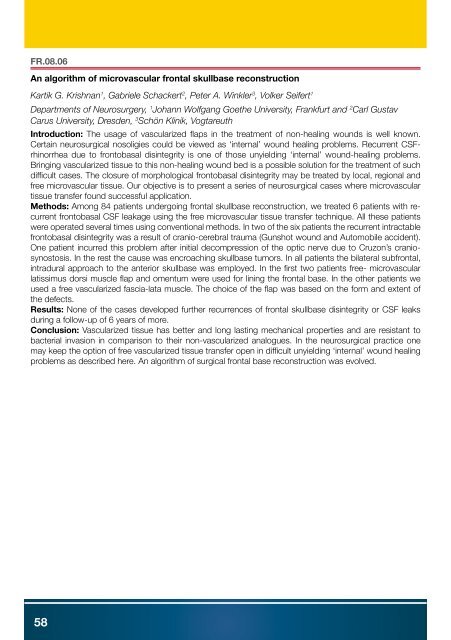Programm www .dgsb2010 .de
Programm www .dgsb2010 .de
Programm www .dgsb2010 .de
Erfolgreiche ePaper selbst erstellen
Machen Sie aus Ihren PDF Publikationen ein blätterbares Flipbook mit unserer einzigartigen Google optimierten e-Paper Software.
FR.08.06<br />
An algorithm of microvascular frontal skullbase reconstruction<br />
Kartik G. Krishnan1 , Gabriele Schackert2 , Peter A. Winkler3 , Volker Seifert1 Departments of Neurosurgery, 1Johann Wolfgang Goethe University, Frankfurt and 2Carl Gustav<br />
Carus University, Dres<strong>de</strong>n, 3Schön Klinik, Vogtareuth<br />
Introduction: The usage of vascularized flaps in the treatment of non-healing wounds is well known .<br />
Certain neurosurgical nosoligies could be viewed as ‘internal’ wound healing problems . Recurrent CSFrhinorrhea<br />
due to frontobasal disintegrity is one of those unyielding ‘internal’ wound-healing problems .<br />
Bringing vascularized tissue to this non-healing wound bed is a possible solution for the treatment of such<br />
difficult cases . The closure of morphological frontobasal disintegrity may be treated by local, regional and<br />
free microvascular tissue . Our objective is to present a series of neurosurgical cases where microvascular<br />
tissue transfer found successful application .<br />
Methods: Among 84 patients un<strong>de</strong>rgoing frontal skullbase reconstruction, we treated 6 patients with recurrent<br />
frontobasal CSF leakage using the free microvascular tissue transfer technique . All these patients<br />
were operated several times using conventional methods . In two of the six patients the recurrent intractable<br />
frontobasal disintegrity was a result of cranio-cerebral trauma (Gunshot wound and Automobile acci<strong>de</strong>nt) .<br />
One patient incurred this problem after initial <strong>de</strong>compression of the optic nerve due to Cruzon’s craniosynostosis<br />
. In the rest the cause was encroaching skullbase tumors . In all patients the bilateral subfrontal,<br />
intradural approach to the anterior skullbase was employed . In the first two patients free- microvascular<br />
latissimus dorsi muscle flap and omentum were used for lining the frontal base . In the other patients we<br />
used a free vascularized fascia-lata muscle . The choice of the flap was based on the form and extent of<br />
the <strong>de</strong>fects .<br />
Results: None of the cases <strong>de</strong>veloped further recurrences of frontal skullbase disintegrity or CSF leaks<br />
during a follow-up of 6 years of more .<br />
Conclusion: Vascularized tissue has better and long lasting mechanical properties and are resistant to<br />
bacterial invasion in comparison to their non-vascularized analogues . In the neurosurgical practice one<br />
may keep the option of free vascularized tissue transfer open in difficult unyielding ‘internal’ wound healing<br />
problems as <strong>de</strong>scribed here . An algorithm of surgical frontal base reconstruction was evolved .<br />
FR.09.01<br />
Aktuelles Management komplexer Schä<strong>de</strong>lbasismeningeom<br />
Volker Seifert<br />
Klinik und Poliklinik für Neurochirurgie, Johann-Wolfgang-Goethe-Universität, Frankfurt/Main<br />
58 59


